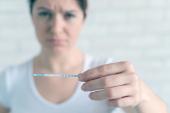Worldwide, Care for Women With Acute HF Falls Short
Women receive less-intensive treatment than men, but still have a survival advantage, except in countries with big income gaps.

Around the globe, women hospitalized with acute heart failure (HF) are less likely than men to receive guideline-recommended therapies, diagnostic testing, and interventions to treat their condition, according to an analysis of the REPORT-HF registry. Worse, women also are more likely to receive medications that could actually lead to or worsen heart failure.
And while 1-year mortality didn’t differ overall, researchers found that women were at a disadvantage in countries that had the greatest income inequality. In countries where wealth was distributed more evenly among residents rather than concentrated in the hands of a few, women were actually more likely to survive than men.
Senior author Carolyn S.P. Lam, MBBS, PhD (Duke-NUS Medical School and National Heart Centre, Singapore), said the study extends prior reports by adding contemporary data on sex differences in HF and exploring the impact of income/wealth distribution.
“Unfortunately, the sex disparities in treatment that we observed are very reminiscent of that seen with other forms of CVD,” she told TCTMD in an email.
Lam advised: “Clinicians first need to be aware of these sex differences (both biological factors and social determinants of health), acknowledge any inherent biases, then address the gaps by considering standardization of clinical approaches regardless of sex.”
Anu Lala, MD (Icahn School of Medicine at Mount Sinai, New York, NY), commenting on the study for TCTMD, said, “In many ways, it was a recapitulation of what we did and do know.”
Even so, the results add many insights, she noted. “This is a very large, multicenter, multinational registry, which is why the data are even more compelling.” The fact that the trends were consistent on an international scale suggests the differences in care are real, said Lala.
Led by Jasper Tromp, MD, PhD, MPH (National University of Singapore and Duke-NUS Medical School, Singapore), the study was published online this week in JACC: Heart Failure.
REPORT-HF Sex Gaps
Tromp et al examined data from the REPORT-AF registry, a global observational cohort study that enrolled 18,553 participants (39% women) from 44 countries across six continents over a 3-year period ending in March 2017. All were hospitalized with a primary diagnosis of acute HF.
Female patients in the database, compared with male patients, were more likely to have heart failure with preserved ejection fraction (40% vs 20%; P < 0.001) and had more-severe signs/symptoms at the time of their admission (dyspnea, orthopnea, and pulmonary rales). They also tended to older (mean age 71 vs 65 years) and were more likely to have comorbidities (eg, hypertension, atrial fibrillation/flutter, valvular heart disease, and diabetes), though they had a lower prevalence of CAD.
Diagnostic tools and treatment varied by sex. Compared with men, women were more likely to receive an echocardiogram but less apt to undergo coronary angiography and cardiac stress testing, and they had a lower rate of PCI.
Female patients who had heart failure with reduced ejection fraction were less likely to be discharged on a mineralocorticoid receptor antagonist, though other medication use did not differ. Women were more likely than men to receive treatments with the potential to cause or worsen HF, such as short-acting inhaled sympathomimetics, diltiazem, and antidepressants (18% vs 13%; P < 0.0001). And finally, among eligible patients, women were less likely to receive an implantable cardioverter-defibrillator and/or cardiac resynchronization therapy (3% vs 7%; P < 0.001).
Overall, the risk of 1-year mortality was similar for men and women after accounting for potential confounders.
Using data from the World Bank, the researchers also looked at income levels for each country. There were no differences in 1-year survival between male and female patients when analyzed by geographic region, or by their country’s income level.
However, income inequality did carry weight. In countries that had a low level of inequality, as defined by the Gini coefficient, women saw better survival than men (HR 0.82; 95% CI 0.69-0.98). That difference wasn’t apparent for patients in countries with middle (HR 1.10; 95% CI 0.98-1.23) or high (HR 1.06; 95% CI 0.93-1.19) disparities in income, with a P value for interaction of < 0.001. In North America, female patients actually were at higher risk than men of dying by 1 year (HR 1.25; 95% CI 1.01-1.54).
“Since country income inequality tracks well with a country-level gender pay gap, we postulate that that income inequality impacts women more than men, leading to greater limitations on access to high-quality treatment among women,” Lam explained.
Sex-Neutral or Sex-Specific?
Overall, the findings “emphasize an ongoing unmet need to address sex differences in HF management,” Tromp and colleagues say, suggesting that “sex-neutral interventions” such as electronic decision support tools or polypills could prove helpful.
Lala suggested that a “one-size-fits-all mentality” might not suffice. “We may indeed be at the point where we have to [offer] individualized care more so than we're doing currently,” she said, adding that gender and sex are key factors to consider. “I think we have to remain humble to know that it can't just be as protocolized as we would sometimes like it to be.”
Heart failure is unique in that respect, Lala continued. “Sex and gender affect every aspect of heart failure, arguably even more than the other subspecialties in cardiovascular disease.”
To start, she explained, there are sex-specific risk factors—such as autoimmune disease, pregnancy, and breast cancer-related therapies—that disproportionately affect women. “Then the manifestations are different, as well, with the predominance of heart failure with preserved ejection fraction,” she noted. “We know that the ejection fractions are higher for women in general compared to men. The QRS duration is a little shorter than it is for men.”
And then, as in cardiology as a whole, there’s less utilization of devices and other invasive therapies among women compared with men.
To TCTMD, Lam said that more details on socioeconomic status, education level, and cultural norms—which were not captured in the current study—would also help shed light on the disparities in care.
She suggested, too, that implementation studies should test both sex-specific and sex-neutral approaches to HF care, a proposal set out in an editorial by Nosheen Reza, MD (University of Pennsylvania, Philadelphia).
“To overcome these seemingly colossal barriers to sex and gender equity in HF care, a potential way forward may be to construct standardized care paradigms, agnostic to patient sex, that are scalable across a diversity of care settings and cultures,” Reza writes. On the other hand, “another potential strategy may be to institute care protocols that acknowledge the sex differences in treatment that have been repeatedly demonstrated and incorporate nudges or other mechanisms that aim to circumvent provider- and system-level sex biases.”
Caitlin E. Cox is News Editor of TCTMD and Associate Director, Editorial Content at the Cardiovascular Research Foundation. She produces the…
Read Full BioSources
Tromp J, Ezekowitz JA, Ouwerkerk W, et al. Global variations according to sex in patients hospitalized for heart failure in the REPORT-HF registry. J Am Coll Cardiol HF. 2023;11:1262–1271.
Reza, N. A woman’s work is never done: overcoming sex and income inequalities in heart failure care. J Am Coll Cardiol HF. 2023;11:1272-1274.
Disclosures
- REPORT-HF was funded by Novartis Pharma.
- Tromp is supported by grants from the National University of Singapore, Ministry of Education, and National Medical Research Council; has received consulting or speaker fees from Daiichi Sankyo, Boehringer Ingelheim, Roche Diagnostics, and Us2.ai; and owns patent US-10702247-B2 unrelated to the present work.
- Lam is supported by a Clinician Scientist Award from the National Medical Research Council of Singapore; has received research support from Boston Scientific, Bayer, Roche Diagnostics, AstraZeneca, Medtronic, and Vifor Pharma; has served as consultant or on the advisory board, steering committee, or executive committee for Boston Scientific, Bayer, Roche Diagnostics, AstraZeneca, Medtronic, Vifor Pharma, Novartis, Amgen, Merck, Janssen Research and Development, Menarini, Boehringer Ingelheim, Novo Nordisk, Abbott Diagnostics, Corvia, Stealth BioTherapeutics, JanaCare, Biofourmis, Darma, Applied Therapeutics, MyoKardia, Cytokinetics, WebMD Global, Radcliffe Group, and Corpus; and serves as cofounder and nonexecutive director of eKo.ai.





Comments